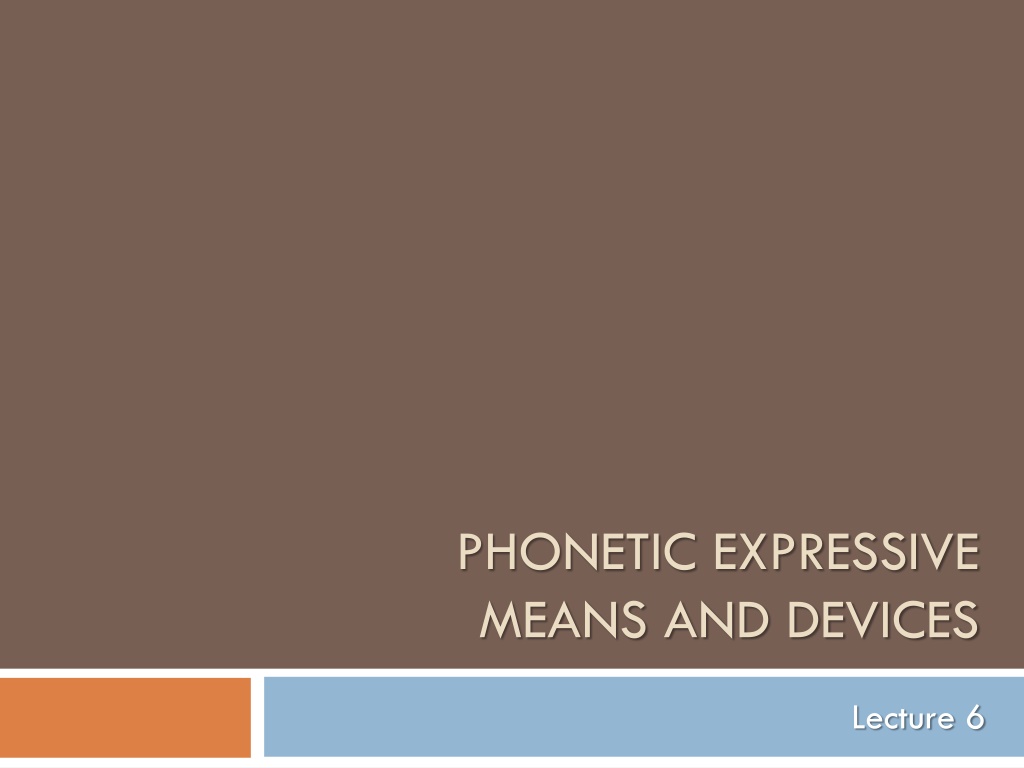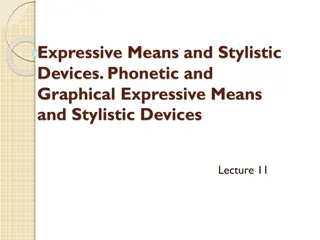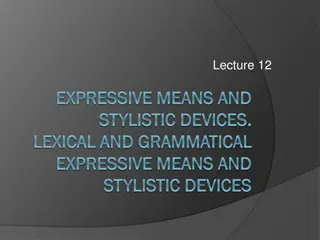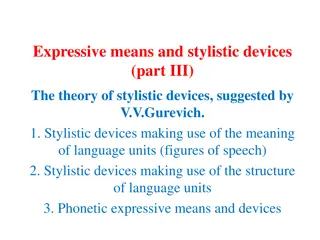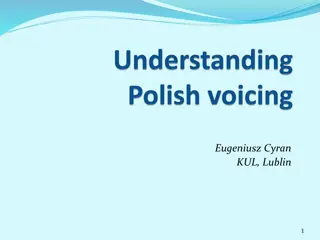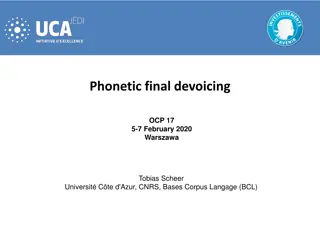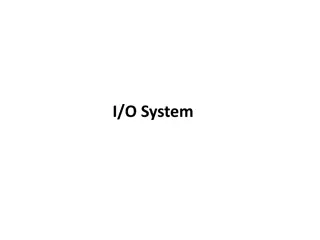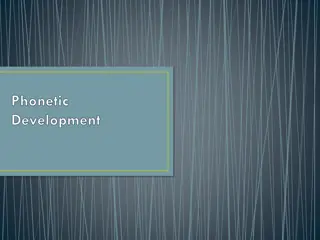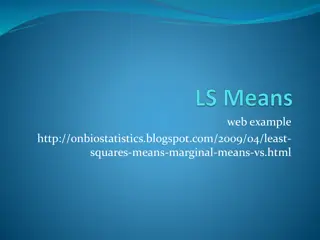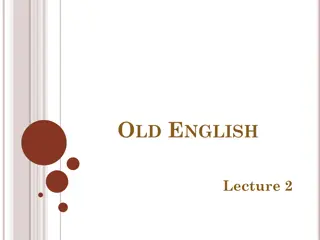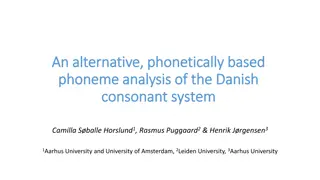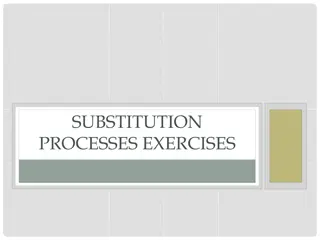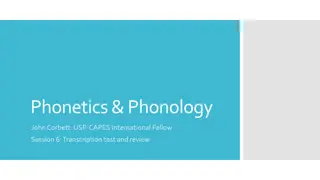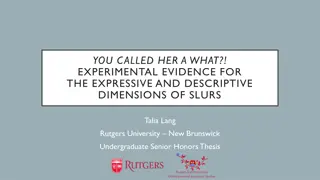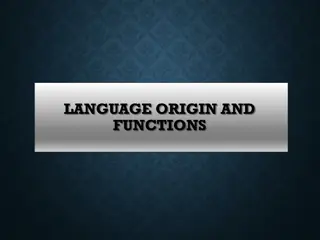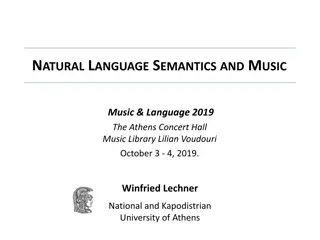Understanding Phonetic Expressive Means and Devices in Language
Phonetic expressive means and devices are utilized to enhance the acoustic effect of speech, emphasizing the utterance and evoking emotions in the audience. These tools come into play both in oral and written forms of communication, directly through intonation and stress in spoken language and indirectly through graphical and syntactical arrangements in written text. Euphony, achieved through phonetic stylistic devices like alliteration, onomatopoeia, rhythm, and rhyme, plays a significant role in creating a pleasing auditory experience. Exploring examples such as alliteration and assonance further illustrates the impact of these techniques on linguistic expression.
Uploaded on Sep 26, 2024 | 0 Views
Download Presentation

Please find below an Image/Link to download the presentation.
The content on the website is provided AS IS for your information and personal use only. It may not be sold, licensed, or shared on other websites without obtaining consent from the author. Download presentation by click this link. If you encounter any issues during the download, it is possible that the publisher has removed the file from their server.
E N D
Presentation Transcript
PHONETIC EXPRESSIVE MEANS AND DEVICES Lecture 6
Phonetic EMs and devices are used to produce a certain acoustic effect, thus giving emphasis to the utterance and arousing emotions in the reader or listener. In oral speech intonation and stress are expressed directly by the speaker. In written speech they are conveyed indirectly by graphical expressive means and by a special syntactical arrangement of utterance inversion, isolated members, parallel constr-s, etc.
Euphony is such a combination of words and such an arrangement of utterance which produces a pleasing acoustic effect. Euphony is generally achieved by such phonetic SDs as: alliteration, onomatopoeia, rhythm and rhyme.
1. Alliteration - is a phonetic stylistic device, which aims at imparting a melodic effect to the utterance by deliberate use of similar consonants in close succession to achieve a euphonic effect. - was a conventional device of OE poetry, which was based on alliteration.
Alliteration like most phonetic EMs, doesn t bear any lexical or other meaning, it is only a sort of musical accompaniment of the utterance Doubting, dreading, dreams no mortals ever dared to dream before (Poe). is widely used in folklore, proverbs, sayings, traditional pairs of words: out of the frying pan into the fire; safe and sound, as fit as a fiddle, a pig in a poke, as busy as a bee
Alliteration: used in prose - a strong melodic and emotional effect: The possessive instinct never stands still (Gals.) poetry: The day is cold and dark and dreary It rains and the wind is never weary. (Longf.) book titles: School for Scandal (R. Sheridan), Pride and Prejudice, Sense and Sensibility (J. Austen), Silver Spoon (J. Galsworthy).
2. Assonance the repetition of vowel sounds to create internal rhyming within phrases or sentences (a rhyme in this case being just the syllabic resemblance): on a proud round cloud in white high night; I must confess that in my quest I felt depressed and restless; Soft language issued from their spitless lips as they swished in low circles round and round the field, winding hither and thither through the weeds.
3. Onomatopoeia is a combination of speech sounds which aim at imitating sounds produced in nature (wind, sea, thunder), by things (machines, tools), by people (sighing, laughter, crying) and by animals. Onomatopoeia is based on metonymy.
Onomatopoeia is often based on and combined with alliteration; may carry on an aesthetic function: act pleasurably or unpleasurably on the reader s feelings. is the poetic device by which sound is used to communicate sense. The moan of doves in immemorial elms. And murmuring of innumerable bees.
Onomatopoeia Direct - is contained in words that imitate natural sounds: buzz, cuckoo, ding-dong Indirect - is a combination of sounds, the aim of which is to make the sound of the utterance an echo of its sense (echo-writing): And the silken, sad, uncertain, rustling of each purple curtain. (E.A. Poe) Indirect O. demands some mention of what makes the sound.
4. Rhythm is a regular alteration of similar or equal units of speech; is a flow, movement, procedure, etc., characterized by basically regular recurrence of elements or features as beat, or accent, in alternation with opposite or different elements or features.
Rhythm in prose is not governed by any definite rules. It is very changeable and is mainly dependent on the author s artistic sense. Certain parts of prosaic descriptions are very rhythmical, which produces a certain stylistic effect. Due to rhythm some utterances may sound very solemn and imposing.
Rhythm in prose is also created by more or less recurrent repetition of some similar units of speech: repetition of all kinds, polysyndeton, asyndeton, inversion, parallelism; heightens the emotional tension of the narration.
Rhythm in poetry - is created by the regular recurrence of stressed and unstressed syllables or equal poetic lines. The regular alternation of stressed and unstressed syllables forms a unit the foot. There are 5 basic feet in English poetry:
Iambus Iambus is a foot consisting of one unstressed syllable followed by one stressed syllable: My SOUL is DARK oh QUICKly STRING The HARP and YET can BROOK be HEARD.
Trochee Trochee is a foot consisting of one stressed syllable followed by one unstressed syllable: FARE thee WELL! And IF for EVer STILL for EVer, FARE thee WELL.
Dactyl Dactyl - is a foot consisting of one stressed syllable followed by two unstressed syllables: HAIL to the CHIEF who in TRIumph adVANces HOnoured and BLESSED be the EVer-green PINE.
Anapest Anapest - is a foot consisting of two unstressed syllables followed by one stressed syllable: He is GONE on the MOUNtain, He is LOST to the FOrest
Amphibrach Amphibrach - is a foot consisting of one unstressed syllable followed by one stressed and one unstressed syllable: The WAters are FLASHing, The WHITE bail is DASHing
Irregular feet The regularity of stressed and unstressed syllables is frequently violated as a result of the natural phonetic laws of the English language or the emphatic stress. The feet of this nature do not typically provide the basis for a metrical line. Instead, they are found as irregular feet in meter based on another type of foot.
Spondee is a metrical foot consisting of two stressed syllables: childhood, love-song, heartbreak, drop-dead
Pyrrhic foot is a metrical foot consisting of two unaccented, short syllables LIGHT of the WORLD / U U /
Meter - the basic rhythmic structure of a verse. A metrical line is named based on the number of feet that are in that line: According to the number of feet per line: 1 monometer 5 pentameter 2 dimeter 6 hexameter 3 trimeter 7 heptameter 4 tetrameter 8 octameter
Feet and Meters Foot Iamb Trochee Meter Iambic Trochaic Dactyl Amphibrach Anapest Dactylic Amphibrachic Anapestic Spondee Pyrrhic foot Spondaic Pyrrhic
Metrical Foot + Line Length = Meter A verse is named from the number of prevailing feet.
Identifying meter TIS the HOUR when HAPpy FAces / U / U / U / U SMILE aROUND the TAper's LIGHT; / U / U / U / WHO will FILL our VAcant PLAces? / U / U / U / U WHO will SING our SONGS to-NIGHT? / U / U / U / / U trochee / U repeated 4 times trochaic tetrameter
Free verse vs. blank verse Free verse (vers libre) verse without a fixed metrical pattern: the rhythm required by the poem, the nature of things becomes more important than following a regular accentual pattern Blank verse unrhymed iambic pentameter: Five years have past; five summers, with the length Of FIVE long WINters! AND aGAIN I HEAR These waters, rolling from their mountain-springs With a soft inland murmur. Once again Do I behold these steep and lofty cliffs...
5. Rhyme is the repetition of identical or similar terminal sound combinations. Rhyming words are generally placed at a regular distance from each other. In verse they are usually placed at the end of the corresponding lines.
Rhyme is one of the means of creating euphony. In poetry rhyme is considered to be quite normal; in prose it sounds pretty abnormal, is considered to be a violation of euphony. Yet, some authors resort to rhyming in order to achieve a humorous or satirical effect: Billy, don t think me silly.
= the similarity of sounds: Full rhyme (perfect) the likeness between the vowel sounds in the last stressed syllables and all sounds that follow them: tenderly slenderly; finding binding; know though. Imperfect (slant rhymes) usually the similarity to the eye, or spelling similarity (eye-rhymes): proved loved; brood blood; slow law, dizzy easy.
= the structure of rhymes Masculine (single) the similarity of one stressed final syllable: plain rain; find declined; Feminine (double) the similarity of one stressed syll. followed by one unstressed syll.: daughter water, mountain fountain; Dactyl (triple) the similarity of one stressed syllable followed by two unstressed syllables: affection reflection; magnanimity sublimity.
= the structure of rhymes Masculine and feminine rhymes are most often used in E. poetry. Sometimes they regularly alternate: When the lamp is shattered, The light in the dusk lies dead, When the cloud is scattered, The rainbow s glory is shed. Full double or broken rhyme a specific type of rhyme made by separate words: bound me around me.
= the arrangement of rhymes Couple rhyme the 1stand the 2ndlines rhyme together (a a): Away, away from men and towns, To the wild woods and the downs. Cross rhyme the 1stand the 3rdlines rhyme together (a b a b) Four seasons fill the measure of the year; There are four seasons in the mind of man: He has his lusty spring, when fancy clear Takes in all beauty with an easy span
= the arrangement of rhymes Frame rhyme the 1stand the 4thlines rhyme together (a..b..b..a) Love, faithful love recalled thee to my mind But how could I forget thee? Through what power Even for the least division of an hour Have I been so beguiled as to be blind? Internal rhyme exists between the middle and final words or syllables of a verse: The fair breeze blew, the white foam flew, The furrow followed free; We were the first that ever burst Into that silent sea
The functions of rhyme it signalizes the end of a line, marks the arrangement of lines into stanzas; makes rhythm manifest and easily perceptible; adds greater prominence to the most emphatic place in a poetic line the end.
